Discover 20 hidden attractions, cool sights, and unusual things to do in Jinan (China). Don't miss out on these must-see attractions: Baotu Spring, Xingguo Temple, and Sacred Heart Cathedral. Also, be sure to include Thousand Buddha Mountain in your itinerary.
Below, you can find the list of the most amazing places you should visit in Jinan (Shandong).
Table of Contents
Baotu Spring
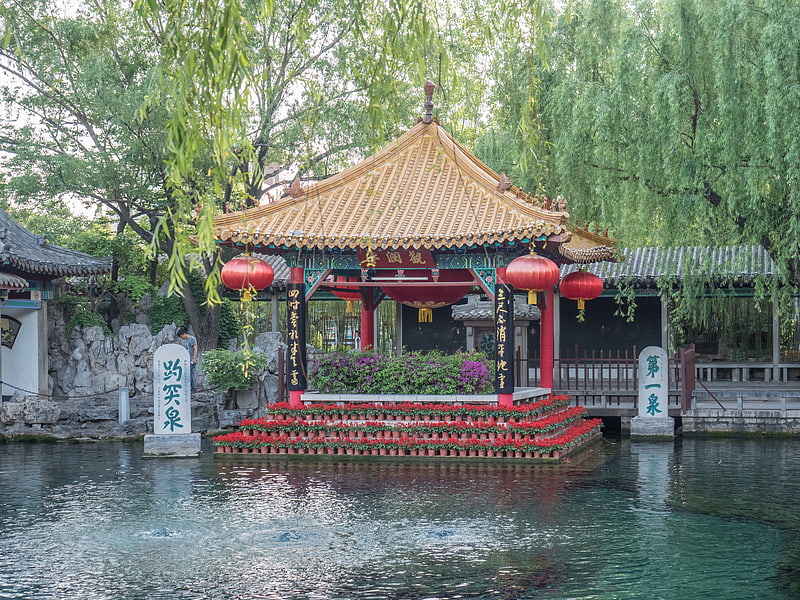
Also known as: 趵突泉
National park in Jinan, China. The Baotu Spring is a culturally significant artesian karst spring located in the city of Jinan, Shandong, China. It is mentioned in the Spring and Autumn Annals, one of the Five Classics of Chinese literature, and was declared the "Number One Spring under the Heaven" by the Qianlong Emperor in the Qing dynasty.
The Baotu Spring is the most renowned among the more than 70 named artesian springs in the downtown area of the city of Jinan. The water of all these springs originates from an Ordovician karst aquifer under the city. As the terrain around Jinan slopes from the south down to the north, the recharge area for the aquifer is located in the mountainous area to the south of the city. The recharge area of the springs covers 1,500 square kilometres, out of which 550 km2 provide direct recharge and 950 km2 indirect recharge.
Altogether, the springs fed by the aquifer have a discharge of about 300,000-350,000 cubic metres per day. Since the 1970s, the springs have stopped flowing several times because too much water has been taken out from the aquifer for human consumption.
The Baotu Spring is part of a cluster of about 20 named springs. Water age estimates suggest that its water originates from shallow circulation.
The spring pool of the Baotu Spring is fed by an underwater limestone water through three outlets; the volume of the water coming out of the spring can reach peak values up to 1.6 cubic metres per second. The water jets from the spring are said to have reached highs up to 26 metres. The water temperature remains constant of 18 degree Celsius through the entire year.[1]
Address: 1 Baotuquan South Rd, Lixia District, Jinan
Xingguo Temple
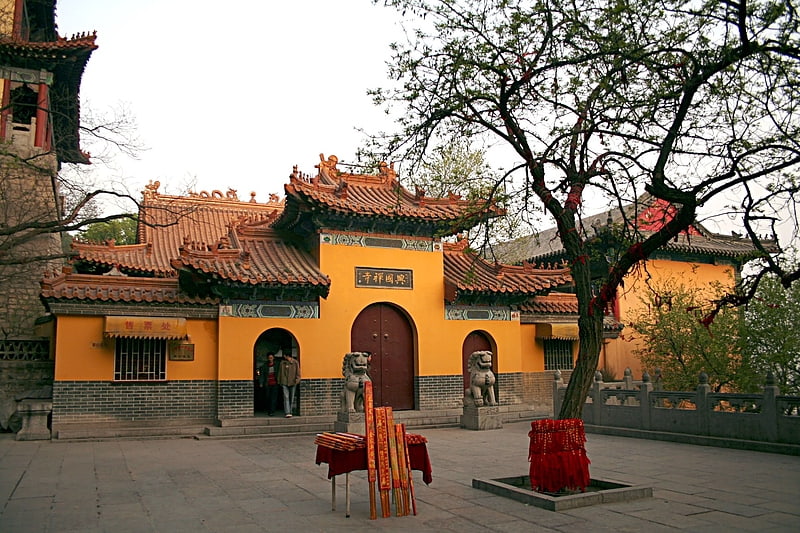
Xingguo Temple is a Buddhist temple located in Zhangqiu District of Jinan, Shandong.[2]
Sacred Heart Cathedral
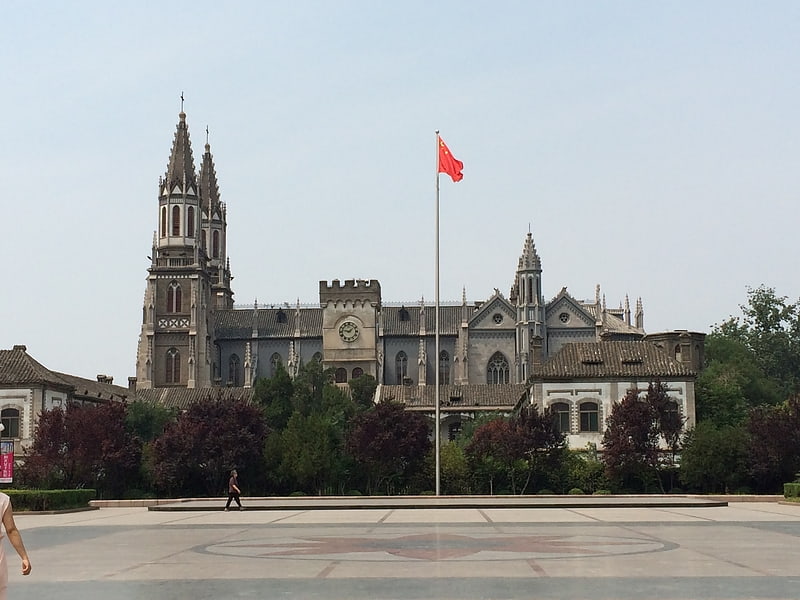
Also known as: 洪家楼教堂
Cathedral in Jinan, China. The Sacred Heart Cathedral, commonly called the Hongjialou Cathedral, is the cathedral of the Roman Catholic Archdiocese of Jinan in the city of Jinan, the capital of Shandong Province, China. It is the largest church in the region and a landmark of Jinan.
The cathedral was constructed during the years 1901 to 1905 (and extended again in 1906). The building project was financed with funds from the indemnity that was stipulated by the Boxer Protocol. The basic layout of this Gothic Revival church is a Latin cross with two tall towers. It is reminiscent of Notre Dame de Paris. The main building of the church covers 1650 square meters and can accommodate about 800 people. The architect was the Franciscan brother Korbinian Paugger (庞会襄, born in Bolzano, died in Brixen in 1949 aged 94). The builder was the mason Lu Licheng (卢立成) from Suncun (孙村), a village in the Jinan area, who supervised nearly 1000 stonemasons for the construction project.
The cathedral was closed in 1966 due to the Cultural Revolution, its interior furnishings were dismantled. It was reopened again on Christmas Day 1985. In 1992, it was declared a heritage site of Shandong Province.
The cathedral is located between Hongjialou Square and the Hongjialou Campus of Shandong University. The cathedral compound also houses Holy Spirit Seminary (Shengshen Beixiu Yuan, founded in December 1998).[3]
Address: 1 Hongjialou North Rd, Lixia District, Jinan
Thousand Buddha Mountain
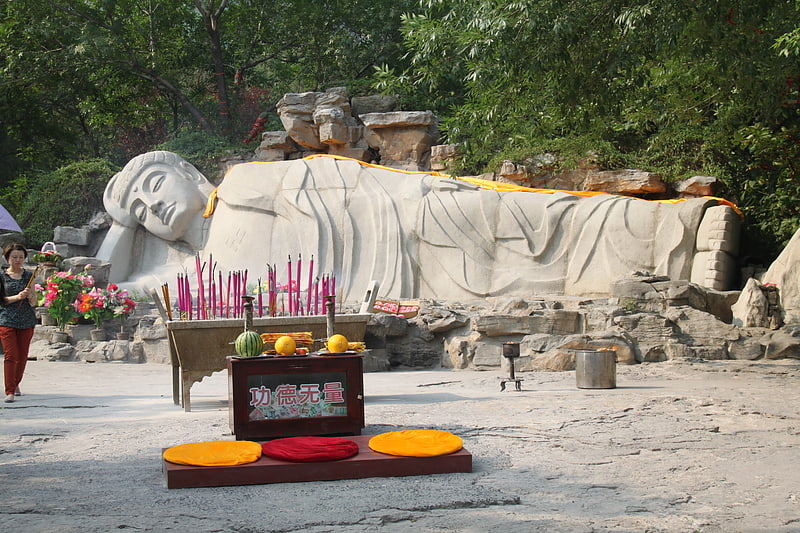
Also known as: 千佛山
Hill in China. The Thousand Buddha Mountain is a hill located about 2.5 kilometers southeast of the city of Jinan, the capital of Shandong Province, China. It covers 1.518 square kilometers and has a peak of 285 meters above sea level. It is renowned for its numerous Buddha images which have been carved out of the hill's rock faces or free-standing structures erect since the times of the Sui Dynasty and its Xingguochan Temple. It is considered one of the "Three Greatest Attractions in Jinan" together with Baotu Spring and Daming Lake. It is also one of the 4A-rated Tourist attractions in China. Thousand Buddha Mountain is opened up as a public park in 1959, rated as AAAA-rated Tourist Attractions of China in 2005, and rated as National Park of China in March 2017.[4]
Five Dragon Pool

Also known as: 五龙潭
Pond in China. The Five Dragon Pool is a culturally significant pond fed by artesian karst springs in the city of Jinan, Shandong Province, China. It is one of the best known springs among the 72 famous springs of Jinan.
The spring that supplies the water for the Five Dragon Pool belongs to a group of springs that also contains 28 other springs, such as the Tianjing Spring, Seventy-three Spring, Ximizhi Spring, Dongmizhi Spring, Yueya Spring, Jing Spring, and the Congming Spring. The water of the Five Dragon Spring originates from the deepest circulation of all the springs in Jinan City.
Legend links the Five Dragon Pool to the Tang Dynasty general Qin Shubao, whose residence is said to have stood at the site. According to the legend, the spring pool formed after torrential rains that submersed Qin Shubao's home.
In 1985, the Five Dragon Pool Public Park was established and the garden landscape surrounding the springs was restored[5]
Liberation Pavilion
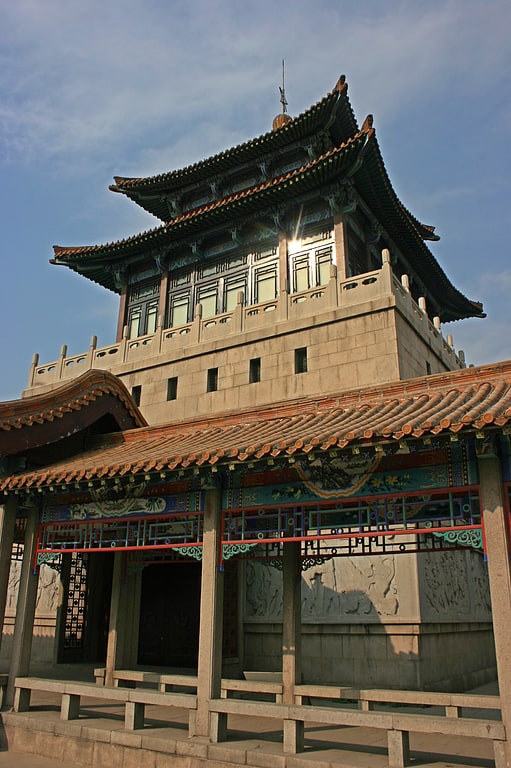
Also known as: 解放阁
Tourist attraction in Jinan, China. The Liberation Pavilion is a monument commemorating the storming of the city of Jinan, Shandong by the People's Liberation Army during the Battle of Jinan in the Chinese Civil War. It stands in the inner south-eastern corner of the city moat near the site where the troops of People's Liberation Army breached the city wall on September 24, 1948. The city wall has since been removed.
Construction of the pavilion was completed in September 1986. The entire structure stands about 34 meters tall and occupies an area of 617 square meters. Its overall architectural design follows classical Chinese patterns. Set on broad stone pedestal, the pavilion proper has two stories and is capped by an eaved roof. However, the sides of the pedestal are decorated with bas-relief stone carvings that depict scenes from the civil-war battle for Jinan in the style of Socialist realism. Another notable decorative feature of the pavilion are the gilded relief inscriptions that read "Liberation Pavilion" on the stone pedestal as well as on the pavilion proper. The characters of these inscriptions were taken from the handwriting of Marshal Chen Yi, who commanded the Shandong counter-offensive during the Chinese Civil War. The interior of the pavilion houses an exhibition related to the civil war battle for Jinan.[6]
Address: Heihuquan Rd West, Jinan
Hua Hill
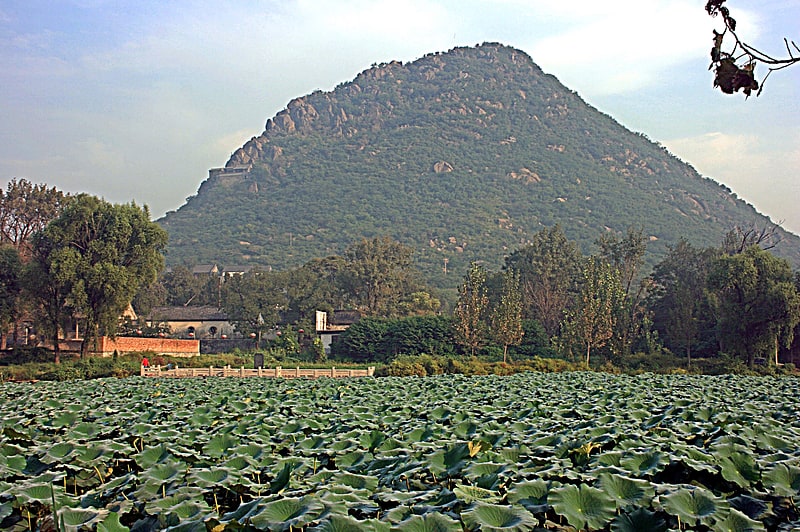
Also known as: 华不注山
Hua Hill is a solitary cone-shaped hill in the lower Yellow River valley, located at the northeastern edge of the city of Jinan, Shandong Province, China. The hill is known for its cultural and historical significance as well as for its natural environment. It has been an inspiration for Chinese artists for many centuries and was the site of the Battle of An, a major battle fought during the Spring and Autumn period.[7]
Jinan Zoo
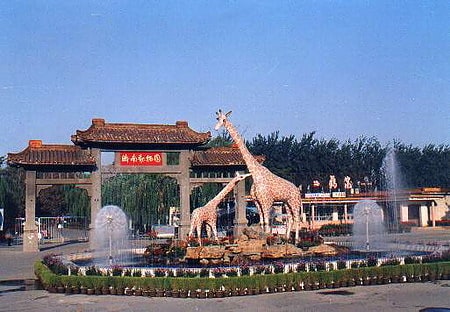
Zoo. Jinan Zoo, formerly known as Taurus Park was founded in October 1959. It opened 1 May 1960, and was renamed Jinan Zoo on 8 September 1989. Jinan Zoo is one of China's largest zoos in it is located in Shandong province.[8]
Hundred Flower Pond
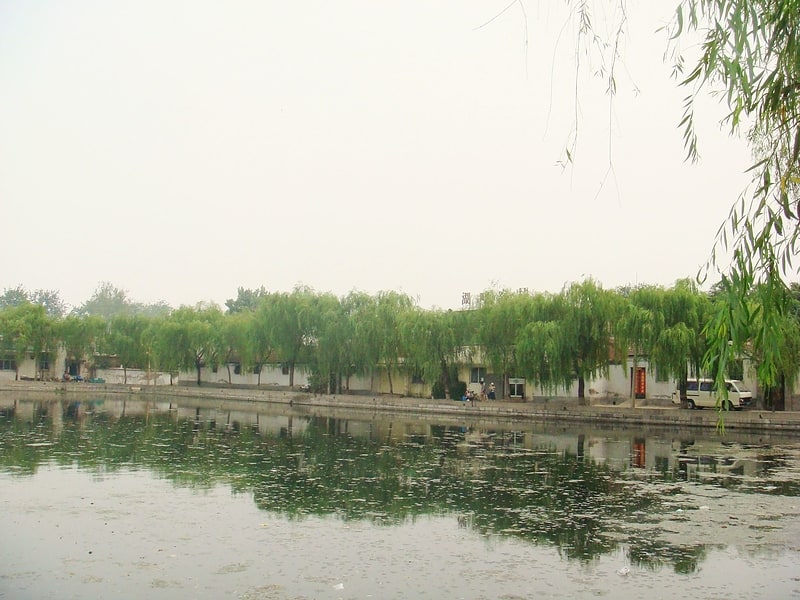
Also known as: 百花洲
Lake. The Hundred Flower Pond is a small artificial lake in the historical center of the City of Jinan, Shandong Province, China. It is located east of the northern end of Qushuiting Street and south of Daming Lake Road.[9]
Daming Lake
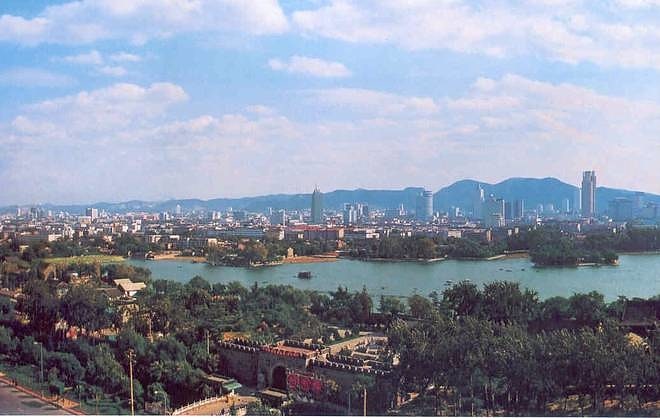
Also known as: 大明湖
Lake in China. Daming Lake is the largest lake in the city of Jinan, Shandong, China and one of city's main natural and cultural landmarks. Located to the north of the historical city center, the lake is fed by the artesian karst springs of the area and hence retains a fairly constant water level through the entire year.[10]
Que Hill
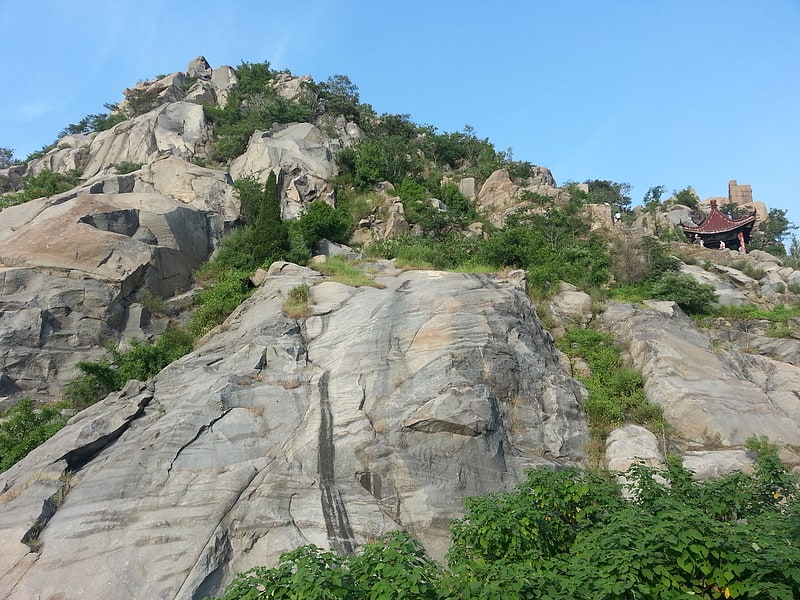
Also known as: 鹊山
Que Hill is a small elongated hill located on the western shore of the Yellow River in the City of Jinan, Shandong Province, China. It is one of the solitary "Nine Hills" in the Yellow River valley within and to the north of Jinan City. Together with Hua Hill, which is today located on the opposite side of the Yellow River, Que Hill is depicted in a renowned painting by the Yuan-Dynasty era painter and calligrapher Zhao Mengfu entitled "Autumn Colors at Que and Hua Hills". The hill is positioned close to the northern end of the Luokou Yellow River Railway Bridge which was placed there because the hill stabilizes the course of the Yellow River. In November 1937, Japanese troops attacked the northern shore of the Yellow River and killed about 50 villagers who lived around Que Hill. The event became known as the Que Hill Tragedy.[11]
Guandi Temple
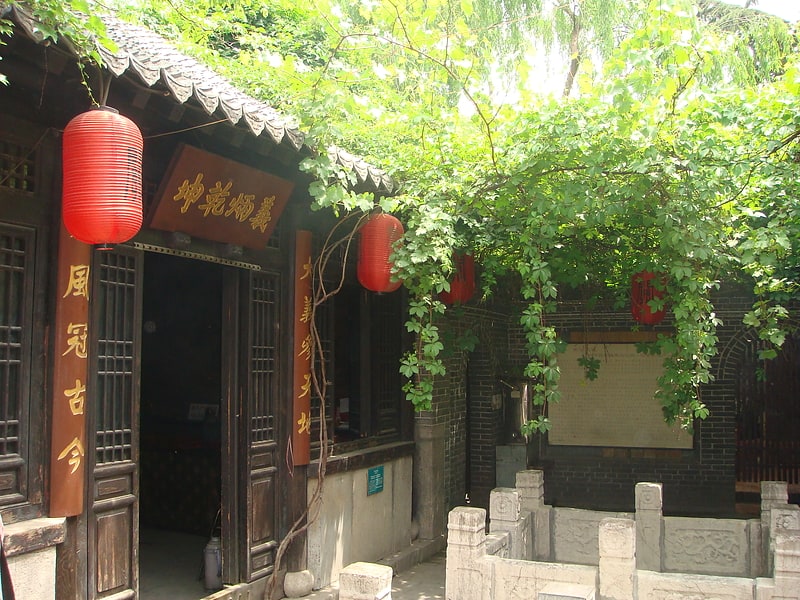
Also known as: 共青团路关帝庙
Buddhist temple in Jinan, China. The Guandi Temple on Communist Youth League Street is a historical temple dedicated to Guan Yu in the Tianqiao district of Jinan, Shandong Province, China. It is one of the three best-preserved Guanyu temples in the area of Jinan, the other two are Guandi Temple in the Water Lily Street and in Xianxi Alley.[12]
Jinan Great Southern Mosque

Also known as: 济南清真南大寺
Mosque in Jinan, China. The Jinan Great Southern Mosque is the oldest mosque in the city of Jinan, Shandong Province, China. It was established during the Yuan dynasty. Most of the present structures were erected during the Ming dynasty. The basic layout of the mosque is that of a Chinese temple into which the elements needed for its function as a mosque have been integrated.[13]
Tomb of Zhang Yanghao
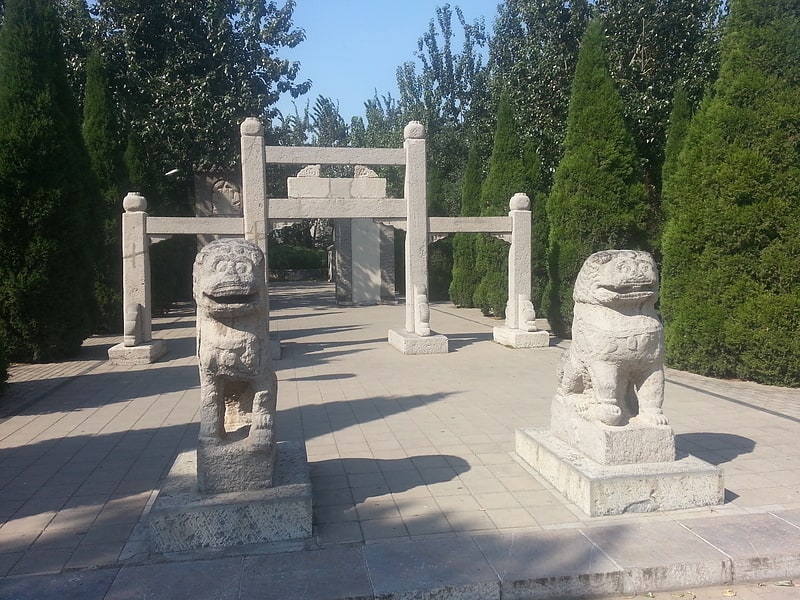
Also known as: 张养浩墓
The Tomb of Zhang Yanghao also known as the Grave of Lord Zhang is a monument to the Yuan-Dynasty Sanqu poet Zhang Yanghao. It is located in a public park in Liu Yun Village within the urban area of Tianqiao District in the city of Jinan, Shandong, China.
The tomb's park covers an area of about 2,000 square meters and is planted with pines and willows. In addition to the tomb of Zhang Yanghao himself, it also contains the tombs of four of Zhang's relatives. The tomb of Zhang Yanghao consists of an earth mound that is 1.9 meter tall and surrounded by masonry walls. In front of the mound stand a stone altar and incense set. A spirit way with stone gates, lions, and turtles leads to the tomb.
The tomb has been inscribed into the list of protected cultural sites in Shandong since June 1992.[14]
Tomb of Min Ziqian
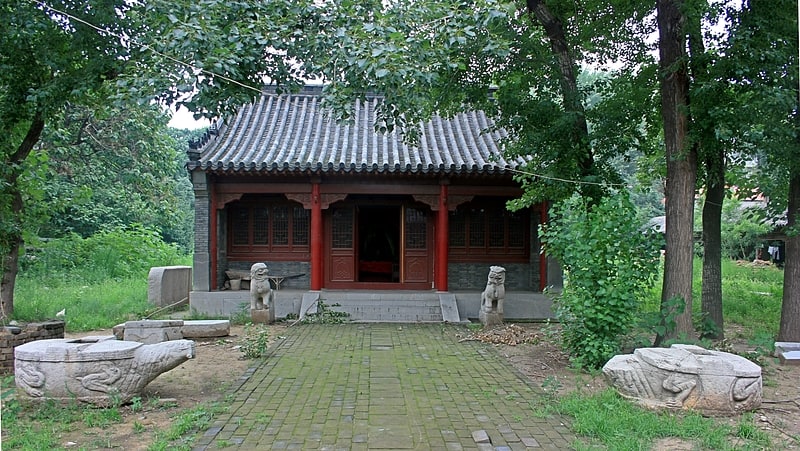
Also known as: 济南闵子骞墓
The Tomb of Min Ziqian is a memorial to Min Sun, a disciple of Confucius and the fourth of the 24 Confucian paragons of filial piety. The memorial is located in Jinan, the capital of Shandong Province, China.
While the memorial is designed as a classical Confucian tomb with an ancestral temple, a spirit way, and a burial mound, the actual burial place of Min Sun is not known. Only some of Min Sun's clothes may have been buried at the Jinan site. Other places in Jiangsu, Henan, and Anhui also have tombs erected to commemorate Min Sun.
The first records of the construction of an ancestral hall dedicated to Min Ziqian on the site in Jinan date to the year 1074 in the period of the Northern Song Dynasty. Renovations were undertaken during the Yuan, Ming and Qing Dynasties. Prior to the Cultural Revolution, the area covered by the memorial spanned about 300 meters in the north–south direction and 200 meters along the east–west axis. The burial mount had a diameter of 78 meters and a height of 10 meters. The site also featured more than 30 old trees and more than 10 historical stone sculptures. The memorial sustained significant damage during the Cultural Revolution, when the ancestral hall was torn down, masonry was destroyed, and trees were cut down. In September 1979, the memorial was identified as the first of Jinan's key historical sites deserving protection. At present, the site covers an area of only 60 by 30 meters. A project to restore the tomb began in 1999, but ran out of funds.[15]
Black Tiger Spring
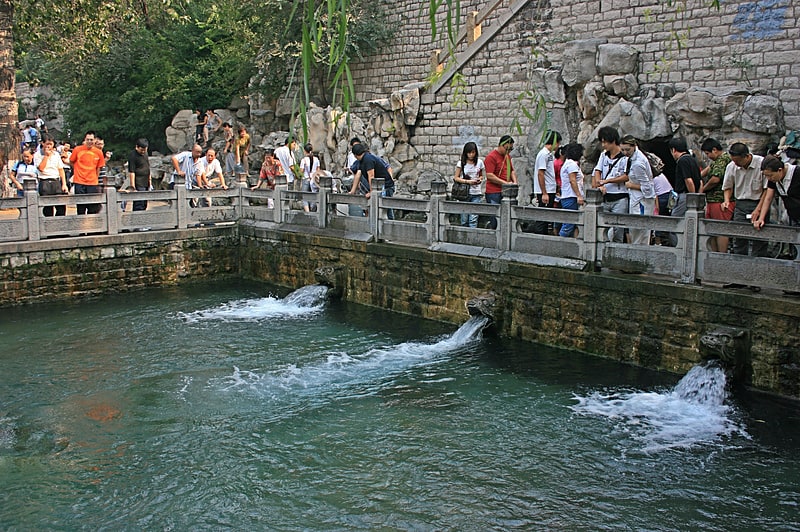
Also known as: 黑虎泉
Tourist attraction in Jinan, China. The Black Tiger Spring is a culturally significant artesian karst spring located in the city of Jinan, Shandong Province, China. The spring is ranked as the second most significant among the 72 named springs in Jinan. The water of the spring stems from moderately-deep circulation and emerges from a water-filled limestone cave in a steep cliff. From the mouth of the cave, the water is funneled to flow out of the mouths of three ornamental stone-carved tiger heads into a square-shaped spring pool. From there it runs into the old city moat, next to which the spring is located. According to the tradition, there was a black rock lying in front of the cave in ancient times. The name of the spring is said to be derived from the shape and color of the rock, which resembled a black tiger, and the sound of the water gushing past the rock being reminiscent of the roar of a tiger. The ancient layout of the spring is described in a poem by the Ming Dynasty poet, Yan Bizeng.[16]
Jinan Yellow River Bridge

Also known as: 济南黄河大桥
Cable-stayed bridge in Jinan, China. The Jinan Yellow River Bridge, also known as the Jinan Yellow River Highway Bridge, is a cable-stayed road bridge across the Yellow River in the city of Jinan, Shandong Province, China.
The national State Planning Commission authorized the plan to construct the Jinan Yellow River bridge on December 10, 1977. In February 1978, engineers Li Shou (Chinese: 李守; pinyin: Lǐ Shŏu) and Wan Shanshan (Chinese: 万珊珊; pinyin: Wàn Shānshān) from the Communication Planning and Design Institute of Shandong Province started to work on the design. In September of the same year, the preliminary design was approved by the Shandong Province construction committee. Test boring at the construction site commenced in July 1978. Work on the bridge proper started officially on December 15, 1978, the bridge assembly was in place by December 1981, and construction was completed on June 30, 1982. Work was carried out by the Communication Engineering Company of Shandong Province. It was supervised by assistant directors Song Ren and Wang Liang as well as assistant commissioner Du Henggan from the department of transportation. The bridge was opened to traffic on July 14, 1982. It was one of the first long-span cable-stayed road bridges in China. The total construction cost was 35,180,000 Yuan RMB. By 1990, the daily average traffic volume had reached 14,179 vehicles (for a 24hour period).
The bridge design has a semi-fan arrangement with steel cables and reinforced concrete H-pylons. The bridge has a total of five spans with the lengths: 40 metres (130 ft) - 94 metres (308 ft) - 220 metres (720 ft) - 94 metres (308 ft) - 20 metres (66 ft). The deck is 17.2 metres (56 ft) wide and 2.75 metres (9 ft 0 in) deep. The pylons are 68.4 metres tall. Together with the access ramps, the bridge has a total length of 2,022.8 metres (6,636 ft).[17]
Memorial for Chairman Mao's inspection of the North Park Commune
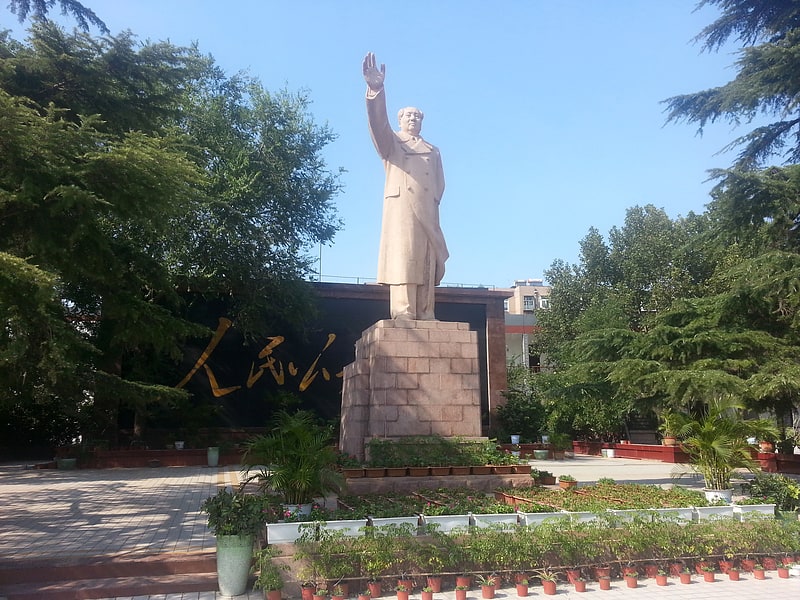
Also known as: 毛主席视察北园公社纪念地
The Memorial for Chairman Mao's Inspection of the North Park Commune is a historical site in the City of Jinan, Shandong, China. The memorial commemorates an inspection visit by Mao Zedong on August 9, 1958, during a tour of the provinces Hebei, Henan. The purpose of the tour was to promote the idea of the People's Commune. During this visit, Mao made the statement "People's Communes are good" which triggered the collectivization in the Great Leap Forward. The North Park Commune was organized on August 20, 1958, a few days after Mao's visit, as the first People's Commune in Shandong.
The site is located on the grounds of the North Park Middle School (北园中学) in Shuitun Village (水屯村), Tianqiao District. It consists of a larger-than-life statue of Mao Zedong positioned in front of an inscription with his remark ("People's Communes are good"). It was inscribed as a historical site protected by Shandong Province in December 1977 (site number 1-01).[18]
Shandong Museum
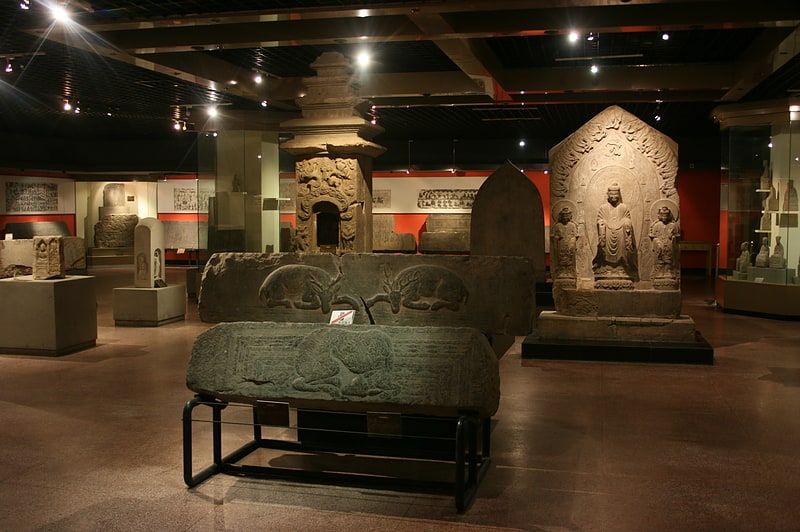
Also known as: 山东博物馆
Museum in Jinan, China. The Shandong Museum is the principal museum of Shandong Province. It is located in the City of Jinan, Shandong, China. It is one of the largest museums in the country.
The Shandong Museum occupies a building with 82,900 square meters of space and houses a collection of more than 210,000 historical artifacts. Highlights of the historical collection include relics from the neolithic Dawenkou and Longshan cultures, bronze artifacts from the Shang and Zhou Dynasties, stone carvings from the Han Dynasty, and paintings from the Ming and Qing Dynasties. The natural history section features fossils from Shanwang and a fossil skeleton of Shantungosaurus.
The forerunner of the Shandong Museum, the Yidu Museum, was established by the British Baptist missionary John Sutherland Whitewright in Qingzhou in 1887. The museum moved to Jinan in 1904 and was renamed to Guangzhi Yuan. In 1942, the museum expanded to a building in the compound of the Red Swastika Society on Shangxin Street. When the Shandong Provincial Museum (Chinese: 山东省博物馆; pinyin: Shāndōng Shěng Bówùguǎn) was founded in 1954, its collection of historical artifacts occupied the compound of the Red Swastika Society, whereas the Guangzhi Yuan housed its natural history collection. In August 1991, construction on a new building for the museum started in the south of Jinan, at the intersection of Li Shan Road and Jing Shiyi Road, near the Thousand Buddha Hill. The building was completed in October 1992, its street address is: Number 14 Jing Shiyi Road, Lixia District, Jinan. In December 2007, ground was broken for a new, significantly larger museum located on Yaojia Street in the Lixia District to the southeast of Jinan's city center. This new museum building was opened to the public on November 16, 2010. The official name of the new museum was shortened from "Shandong Provincial Museum" to "Shandong Museum".[19]
Spring City Square

Also known as: 泉城广场
Tourist attraction in Jinan, China. The Quancheng Square is a square in central Jinan, the capital of China's Shandong Province which is known as the "Spring City". The square has length of 790 meter and width of 280 meter which occupies about 220,000 square meter. The construction started at July 10, 1998 and finished at September 25, 1999. The square consists of Baotu Spring Square, Shandong Celebrities Memorial Hall, Spring City Square, Binhe Square, Sofitel Silver Plaza, Lotus Musical Fountain, Four-Season Garden, Culture Gallery, Technology Center, etc.
The famous statue, Spring, with 38.11 meter height and 170 ton weight at the center of square is designed by Tianren Wang from Xi'an Academy of Fine Arts. The inspiration of this statue comes from the "Spring" (泉) character in Seal Script (篆), which is an ancient style of Chinese calligraphy. It now has become a symbol of Jinan.[20]